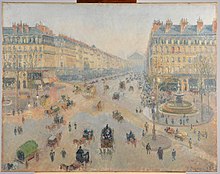
Back تجديد هوسمان في باريس Arabic Parisin yenidənqurulması Azerbaijani Вялікая перабудова Парыжа Byelorussian Reforma urbana de París Catalan Přestavba Paříže během druhého císařství Czech Umgestaltung von Paris während des Zweiten Kaiserreichs German Μετασχηματισμός του Παρισιού κατά τη Δεύτερη Αυτοκρατορία Greek Transformaciones de París durante el Segundo Imperio Spanish Haussmanni linnauuendus Pariisis Estonian Parisko eraldaketak Bigarren Inperioan Basque



| History of Paris |
|---|
 |
| See also |
|
|
Haussmann's renovation of Paris was a vast public works programme commissioned by French Emperor Napoleon III and directed by his prefect of the Seine, Georges-Eugène Haussmann, between 1853 and 1870. It included the demolition of medieval neighbourhoods that were deemed overcrowded and unhealthy by officials at the time, the building of wide avenues, new parks and squares, the annexation of the suburbs surrounding Paris, and the construction of new sewers, fountains and aqueducts. Haussmann's work was met with fierce opposition, and he was dismissed by Napoleon III in 1870. Work on his projects continued until 1927. The street plan and distinctive appearance of the centre of Paris today are largely the result of Haussmann's renovation.